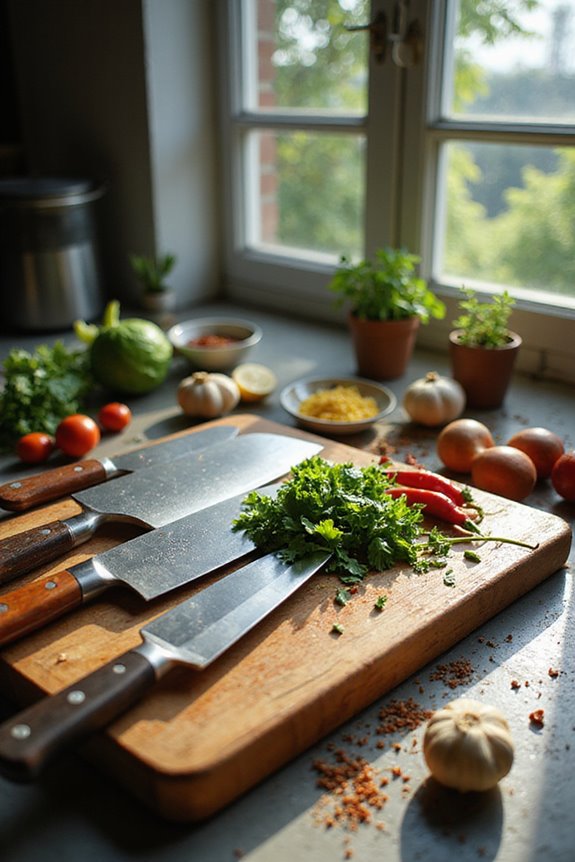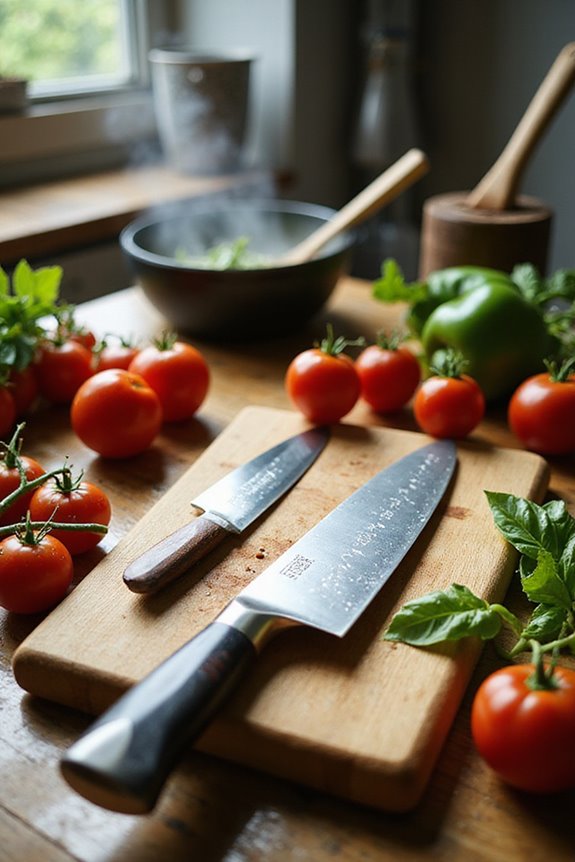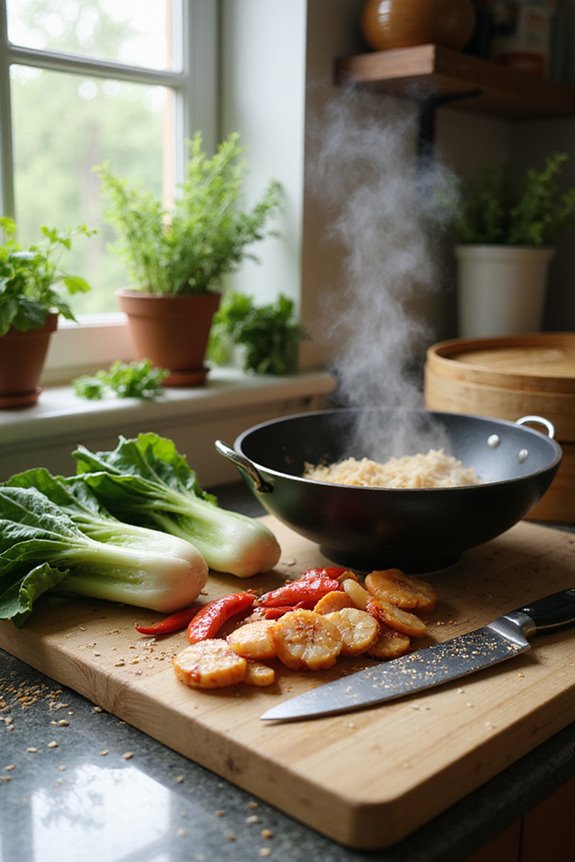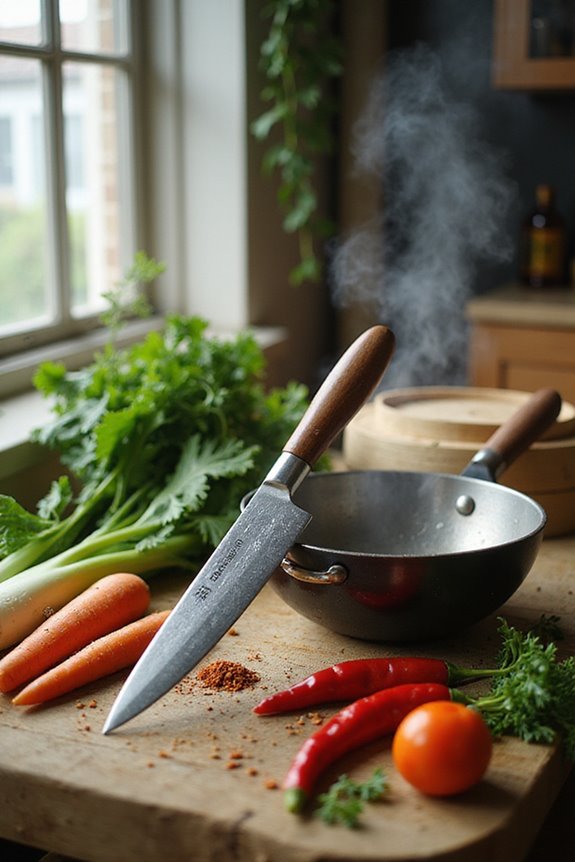As an Amazon Associate, we earn from qualifying purchases. Some links may be affiliate links at no extra cost to you. Although our opinions are based on curated research, we haven't used these products. Articles generated with AI.
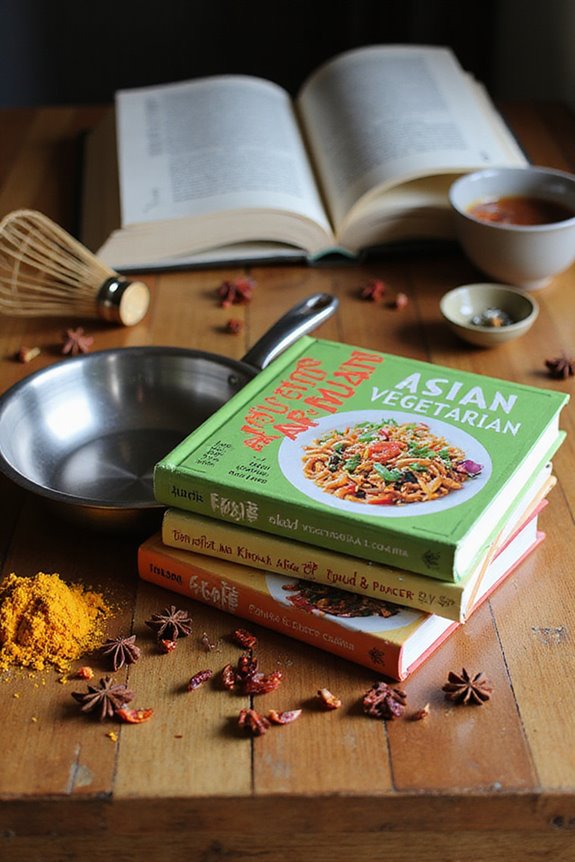
3 Best Asian Vegetarian Cookbooks for Delicious Plant-Based Recipes
For the best Asian vegetarian cookbooks, try “Big Vegan Flavor” for mastering techniques with 150 diverse recipes, perfect for those who love vegan cooking. Next, “Make It Plant-Based! Indian Cookbook” offers a modern twist on traditional Indian recipes, featuring accessible dishes for beginners. Finally, “Veganbells Indian Vegan Cookbook” simplifies Indian cuisine with 90 easy, plant-based recipes while providing nutritional insights. Each book makes cooking enjoyable, so you can explore even more plant-based options ahead.
Key Takeaways
- Big Vegan Flavor offers a diverse range of techniques and 150 recipes, enhancing confidence in plant-based cooking while catering to various tastes.
- Make It Plant-Based! Indian Cookbook combines traditional Indian flavors with modern ingredients, perfect for beginners seeking accessible yet authentic recipes.
- Veganbells Indian Vegan Cookbook presents 90 easy, single-page recipes with nutritional breakdowns, simplifying the cooking process for plant-based Indian cuisine lovers.
- Focus on authentic flavors by using traditional spices and ingredients crucial for achieving a true Asian culinary experience.
- Ensure ingredient accessibility to prevent dissatisfaction and simplify the cooking experience, making vegetarian cooking enjoyable and rewarding.
Big Vegan Flavor: Techniques and 150 Recipes to Master Vegan Cooking
Sale
Big Vegan Flavor: Techniques and 150 Recipes to Master Vegan Cooking
- Hardcover Book
- Vora, Nisha (Author)
- English (Publication Language)
If you’re enthusiastic to elevate your plant-based cooking skills, “Big Vegan Flavor: Techniques and 150 Recipes to Master Vegan Cooking” is an excellent choice. This well-structured cookbook offers three key sections that focus on mastering techniques, building essential ingredients, and providing recipes. While some recipes may seem complex and require significant resources, the doable Flavor Boosters section will help you enhance everyday meals effortlessly. Remember, substitutions are encouraged, making it adaptable for various dietary preferences. Enjoy flipping through its visually appealing pages; it’s both a practical guide and a beautiful addition to your kitchen collection.
Best For: Those looking to enhance their plant-based cooking skills, whether they’re seasoned chefs or beginners.
Pros:
- Diverse Recipes: Offers a wide variety of recipes that cater to different tastes and dietary preferences.
- Visual Appeal: Beautiful photography makes the book enjoyable to read and a great addition to kitchen decor.
- Educational Content: Provides detailed explanations and techniques that build cooking confidence and adaptability.
Cons:
- Complex Recipes: Some recipes can be lengthy and require hard-to-find ingredients, making them challenging for quick meals.
- Health Considerations: Certain ingredients may not align with the preferences of health-conscious readers.
- Space Requirements: The substantial size of the book may necessitate dedicated storage space in the kitchen.
Make It Plant-Based! Indian Cookbook
Sale
Make It Plant-Based! Indian: 50+ Recipes for Vegan Curries, Chaat, Breakfasts, Breads, and Sweets...
- Hardcover Book
- Jain, Srishti (Author)
- English (Publication Language)
The “Make It Plant-Based! Indian Cookbook” offers a rejuvenating take on Indian cuisine, blending tradition with modern plant-based ingredients. You’ll find accessible recipes bursting with authentic flavors that are easy to follow, making it perfect for beginners. With stunning photography and vibrant colors, the book is visually enchanting, drawing you in as you flip through its pages. Srishti enriches the experience by sharing personal stories and tips, creating a warm atmosphere. Ideal for families, the recipes like tofu tikka and oat milk chai are designed to excite even the pickiest eaters about vegetables. It’s a fantastic gift for cooking enthusiasts!
Best For: The “Make It Plant-Based! Indian Cookbook” is best for anyone looking to explore flavorful, plant-based Indian cuisine, especially beginners and families.
Pros:
- Recipes are clear, approachable, and rich in authentic flavor, making them easy for beginners to try.
- The vibrant photography and design enhance the cooking experience and make the cookbook visually appealing.
- Personal anecdotes and tips from the author create a warm and inviting atmosphere, making it more than just a recipe book.
Cons:
- Some traditionalists may prefer classic recipes without modern twists or non-native ingredients.
- Certain ingredients may be harder to find depending on your location, limiting accessibility for some recipes.
- As it focuses on plant-based cooking, meat lovers may find fewer options that cater to their preferences.
Veganbells Indian Vegan Cookbook: 90 Easy, Plant-Based Recipes from India
Veganbell's Indian Vegan Cookbook: 90 Easy, Plant-Based Recipes from India
- Amazon Kindle Edition
- Pokhrel, Neelam (Author)
- English (Publication Language)
Looking for a straightforward way to immerse yourself in vegan Indian cooking? “Veganbells Indian Vegan Cookbook” is perfect for home cooks who want to explore the rich flavors of India without feeling overwhelmed. With 90 easy, plant-based recipes, this cookbook simplifies Indian cuisine, breaking down complex dishes into manageable steps. You’ll appreciate the user-friendly layout, where most recipes fit on a single page, and larger fonts make for easy reading. Nutritional breakdowns accompany each recipe, ensuring you know what you’re cooking. With delightful dishes like Dal Makhani and Garlic Naan, you’ll feel accomplished and inspired to cook more delicious meals.
Best For: Home cooks seeking an easy and enjoyable way to explore vegan Indian cuisine without feeling overwhelmed.
Pros:
- User-friendly formatting with most recipes on a single page and larger fonts for easy reading.
- Wide variety of authentic recipes that cater to vegan dietary needs, including curries, dals, and desserts.
- Nutritional breakdowns provided for each recipe, helping cooks understand the health benefits of their dishes.
Cons:
- Some ingredients may only be available at Indian or Asian grocery stores, requiring extra effort to source.
- Certain recipes may still be complex for absolute beginners despite simplifications.
- A few users might find the lack of a detailed introduction to Indian cooking traditions limiting.
Factors to Consider When Choosing an Asian Vegetarian Cookbook Plant Based.
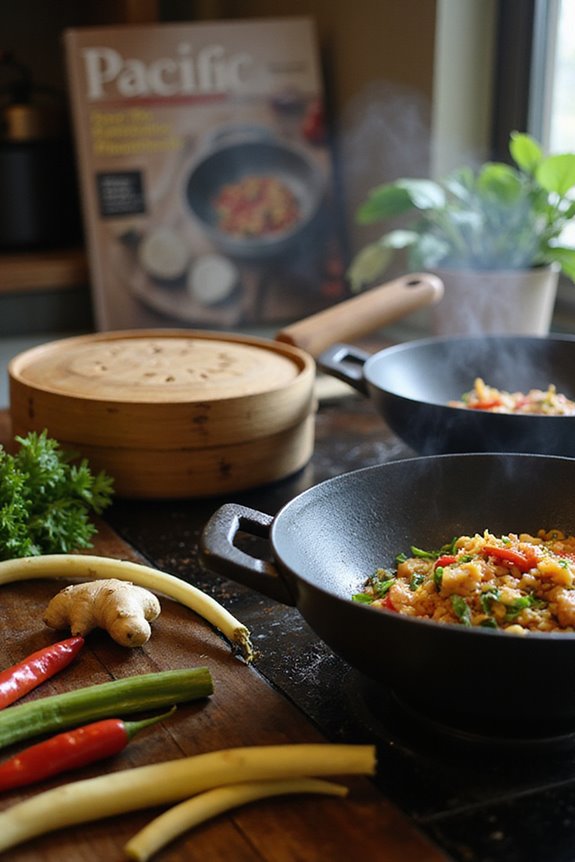
When picking an Asian vegetarian cookbook, think about a few key factors to guarantee it meets your needs. You’ll want recipes that stay true to traditional flavors, ascertain you can easily find the ingredients, and offer a visually appealing presentation. Additionally, consider how simple the preparation is and whether there are tips to enhance the flavors even further.
Recipe Authenticity and Flavor
Choosing an Asian vegetarian cookbook that embodies both authenticity and flavor can transform your cooking experience. Look for recipes that use traditional ingredients and spices, as these are essential for capturing the cuisine’s true tastes. Authenticity also depends on maintaining the original cooking techniques, which can deepen your understanding of each dish’s cultural significance. Pay attention to flavor profiles, ideally balancing sweet, savory, sour, and spicy elements. In addition, cookbooks that share personal anecdotes about the recipes can enrich your culinary journey, connecting you to the dish’s heritage. Ultimately, while authentic recipes are important, make sure they include readily available ingredients or easy substitutions to keep the flavors aligned with their origins. Enjoy your cooking adventure!
Ingredient Accessibility and Freshness
Authenticity in Asian vegetarian cooking often hinges on the accessibility and freshness of the ingredients used. When choosing a cookbook, consider how easily you can find specific spices and produce in your area. Fresh ingredients are essential, as vibrant flavors depend on high-quality vegetables, herbs, and spices. Opt for recipes that incorporate locally sourced and seasonal items for the best results. Look for cookbooks offering alternatives for hard-to-find ingredients, enhancing your cooking experience while keeping the essence of the dishes intact. Understanding the availability of staples like rice, noodles, and legumes guarantees you can prepare meals practically. Additionally, a well-structured cookbook may include information on locating specialty ingredients, assuring you have the freshest options for your dishes.
Visual Appeal and Presentation
How much does visual appeal influence your enjoyment of cooking? A well-designed Asian vegetarian cookbook enhances your cooking experience with vibrant colors and stunning photography that draws you in. The layout should be user-friendly, making it easy to navigate recipes with larger fonts and clear sections. Books with beautiful cover designs and stylish food photography can double as attractive coffee table pieces. Personal stories about the cultural significance of dishes add warmth, enriching your connection to the recipes. Additionally, recipes paired with mouthwatering images give you a visual reference, setting clear expectations for your dishes and motivating you to recreate those delicious flavors at home. Choose cookbooks that engage both your eyes and your taste buds.
Ease of Preparation
When it comes to exploring Asian vegetarian cookbooks, ease of preparation plays an important role in your cooking journey. Look for cookbooks that offer clear and approachable recipes, perfect for beginners. You’ll want recipes that fit on a single page, allowing you to reference easily while cooking. Nutritional breakdowns and preparation times are essential, as they help with meal planning and efficiency in the kitchen. Choose books that simplify complex dishes into manageable steps, making the cooking process feel less intimidating. Finally, assess the variety offered, ensuring the recipes encompass diverse flavors and ingredients while remaining easy to prepare. This way, you’ll create delicious meals without feeling overwhelmed.
Tips for Flavor Enhancements
To elevate the flavors of your plant-based dishes, selecting an Asian vegetarian cookbook that emphasizes flavor enhancement is essential. Look for recipes that incorporate umami-rich ingredients like mushrooms and miso, which deepen the flavor profile. Utilizing spices and herbs common in Asian cuisine—like ginger, garlic, and lemongrass—can greatly elevate taste and aroma. Don’t forget about texture; adding crunchy elements such as toasted nuts or seeds can enhance your meals. Also, consider flavor boosters like soy sauce or tamari, which add depth without overpowering the dish. Finally, balance sweet, sour, salty, and spicy elements to create satisfying meals that reflect the complexity of Asian cuisines. This approach will truly elevate your culinary experience.
Frequently Asked Questions
Are These Cookbooks Suitable for Beginners in Vegetarian Cooking?
Did you know around 60% of new vegetarians struggle to find easy, accessible recipes? If you’re a beginner, these cookbooks often feature straightforward instructions and simple ingredients, making your shift smoother. They include step-by-step guides, ensuring you can create flavorful meals without feeling overwhelmed. You’ll discover versatile recipes that cater to various tastes, so you can build your confidence in the kitchen while exploring delicious plant-based dishes at your own pace.
Do These Recipes Require Hard-To-Find Ingredients?
The recipes in these cookbooks generally use accessible ingredients, so you won’t struggle to find them. Common items like tofu, soy sauce, and various vegetables are staples. However, you might encounter a few specialty ingredients, such as certain spices or unique condiments, which aren’t always available in regular grocery stores. If you have local Asian markets nearby, you can often find what you need easily. Overall, these recipes focus on simplicity and flavor.
Can I Substitute Ingredients in These Recipes?
Absolutely, you can substitute ingredients in these recipes! In fact, studies show that about 75% of home cooks make ingredient swaps based on availability or personal preference. When choosing substitutes, aim for similar flavors or textures. For instance, if you don’t have tofu, tempeh or seitan can work. Just keep in mind that cooking times might vary, so adjust accordingly. This flexibility lets you customize dishes while still enjoying delicious meals.
Are There Gluten-Free Options in These Cookbooks?
Yes, many cookbooks do offer gluten-free options. When you explore the recipes, look for alternatives like rice noodles or gluten-free soy sauce. These substitutes can help you enjoy delicious meals without gluten. You’ll often find essential tips on ingredient swaps, ensuring your cooking remains flavorful and satisfying. Just check the recipe notes, as they’re likely to indicate which options are gluten-free, making your meal prep easier and more enjoyable.
How Can I Adjust Serving Sizes for These Recipes?
Adjusting serving sizes for recipes is like fine-tuning a musical score—every note matters. To do this, simply determine how many servings you need and calculate a ratio. If a recipe serves four but you need eight, double the ingredients. For fewer servings, divide accordingly. Remember, cooking times might change as well, so keep an eye on the dish’s doneness. It’s all about balancing flavors and ensuring everything comes together perfectly.




